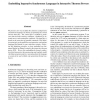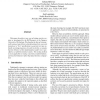91
Voted
ACSD
2001
IEEE
15 years 4 months ago
2001
IEEE
139
click to vote
ACSD
2001
IEEE
15 years 4 months ago
2001
IEEE
We present a new way to define the semantics of imperative synchronous languages by means of separating the control and the data flow. The control flow is defined by predicates th...
ACSD
2001
IEEE
15 years 4 months ago
2001
IEEE
We here consider transition systems of Elementary Net Systems with Inhibitor Arcs. There are basically two di erent types of non-interleaving semantics of such Petri nets, the a-po...
112
click to vote
ACSD
2001
IEEE
15 years 4 months ago
2001
IEEE
This paper presents a method for the automatic synthesis of asynchronous circuits from Petri net specifications. The method is based on a structural encoding of the system in such ...
107
Voted
ACSD
2001
IEEE
15 years 4 months ago
2001
IEEE
We describe a framework where formal models can be rigorously defined and compared, and their interconnections can be unambiguously specified. We use trace algebra and trace struc...
117
Voted
ACSD
2001
IEEE
15 years 4 months ago
2001
IEEE
This paper describes a new way of testing reactive systems as investigated by the RATE-project at the Tampere University of Technology. We abandon the idea of systematically using...
95
Voted
ACSD
2001
IEEE
15 years 4 months ago
2001
IEEE
One of the corner stones of formal methods is the notion traction enables analysis. By the construction of act model we can trade implementation detail for analytical power. The i...
82
Voted
ACSD
2001
IEEE
15 years 4 months ago
2001
IEEE
The correctness of an optimisation of the Transport Capabilities Application Part of the Signalling System No. 7 is formalised as a branching bisimulation which is relaxed to allo...
111
Voted
ACSD
2001
IEEE
15 years 4 months ago
2001
IEEE
Synchronous languages allow a high level, concurrent, and deterministic description the behavior of reactive systems. Thus, they can be used advantageously for the programming of ...


